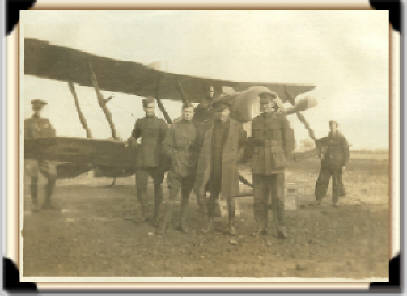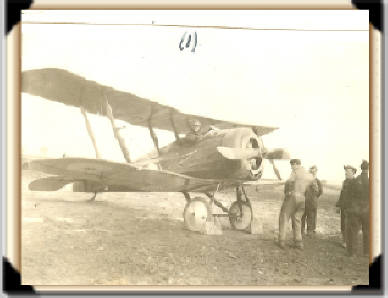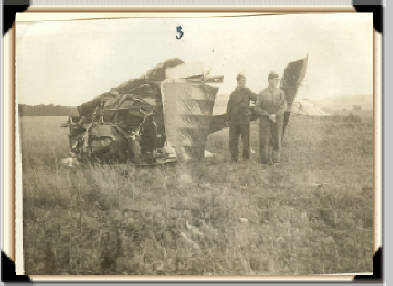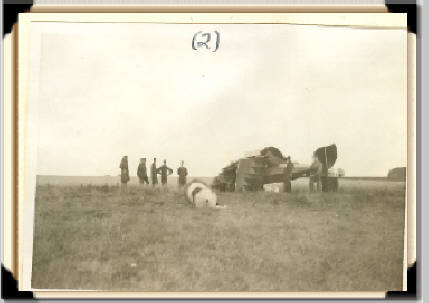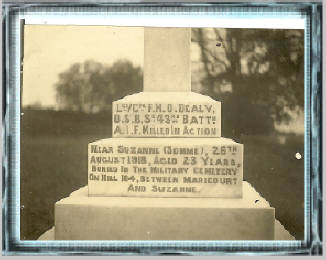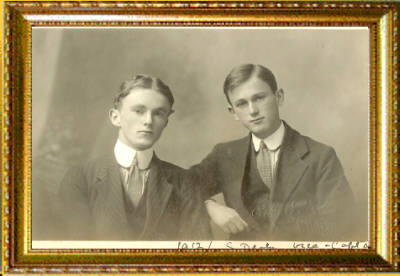On Boxing Day 1917 he had his third accident. The details of this are not on record other than that he had again suffered bad cuts to his face. These were probably the result of at least another heavy landing. But like the other accidents it had been in an old trainer aircraft that ended up as another write off.
Imagine the courage it took to overcome the trauma of the previous two accidents to go up yet again in an aeroplane that was probably on its last legs anyway. A machine that had been used and abused by uncounted other trainee pilots before him…a flimsy thing made of canvas, dope, wood, wire, rubber carrying a hot metal engine and fuelled by petrol …a potential fire ball if ever there was one and armed with live ammunition as well. This time he must have flown from the RFC aerodrome near Market Drayton…..his papers show he paid a mess bill there shortly after. This was a strange irony for reasons that become apparent almost 86 years later. The mess bill was evidence of his survival and his posting to Ayr in Scotland for yet more training before the hoped for posting to the Western Front.
Sydney travelled down to Stonyhurst College in Lancashire early in March to visit his old school. He had gone there also to meet his brother Frank who was then on leave from his Battalion ( 43 rd Battalion Australian Imperial Force) and service in France. At any rate the visit must have been good for Sydney’s morale and self esteem. He would have appeared to the school boys at the time like a demi-god….someone who was not only serving in the armed forces, but who had actually succeeded in becoming a fighter pilot and entitled to the coveted wings of the AFC. One can imagine his being able to tell those young school boys about his time and the adventures he was having…they must have hung on his every word. There is more definite evidence of his seeing some of his old school masters, strong in their Jesuit faith and willing to provide him with words of encouragement and solace. It is highly likely that he would have returned to his duties in Scotland with a stronger sense of purpose and, perhaps, renewed confidence in his own abilities to deal with whatever he would have to face.
All this time of course his mother and sister were in faraway Adelaide South Australia. His father, was still in Hong Kong, as Head master of Queen’s College and as Acting Director of Education, and Chief Censor; separated by war and family circumstances not only from both his two sons but also his wife and daughter. The separation was aggravated not only by distance, but also the slow, imperfect communications of those early days of the primitive telephone and telegraph.
On Wednesday the 6 March Sydney wrote to Frank from the RFC mess at Wellington House, in Ayr Scotland….
" Dear Frank,
It was a pity that we could not see more of each other at Stonyhurst. I was wanted back here because of the probability of being required overseas. I am liable to come over any day though I expect to be here for a few weeks.
I was up this morning …we do nothing but stunts…I was looping, spinning, rolling doing every stunt which I know well.
I hope that you had a real good time in London before going back to France.
As soon as I come over I shall try to dig you up – you can be sure of that.
Your ‘Times" should be renewed from June 14 th . Renew it from June 1 st just to be sure. Just send a cheque or detail the bank to send them 6/6 ( Six shillings and sixpence).
Let me know whether I can do or send out anything for you. Best of luck in the trenches and I do hope you win a stripe or two in the future or better still get across to a school.
I have had no letter from Australia for ages.This place is full of Yanks learning to fly.
I have discovered the Catholic Church today and have tea’d with the padre.
Drop me a line when you can. Love from your affectionate brother,
Syd"
The next day Sydney continued his course in Aerial Fighting. This time he was flying a Sopwith Camel aeroplane. It was afternoon on an early spring day. Presumably he was practicing the usual "stunts", but this time the plane went into a spin from which it never recovered. It nose-dived and violently crashed into the ground, breaking Syd’s neck, killing him instantaneously.
Spencer Haslam, a fellow pilot and friend of Sydney’s wrote afterwards:
"We had hopes of flying together in France. We met just a week or so before he left for Ayr and we saw a lot of each other. He was awfully good to me when I first arrived and we stuck together quite a lot during that short period.
He had gained his wings in record time (6 weeks) and was a very good pilot, although his previous severe crashes, I could see, had told on him a good deal."
Quite so….. it is hard to imagine how much the earlier crashes had affected Sydney. It is even harder to imagine what it must have cost him to go up again in those over used training machines to practice what inevitably would expose him to further immediate risk and later to the even greater risks of real aerial combat. Whatever the cost, he nevertheless determined to accept those risks and in his courage and in his loneliness he faced the inevitable and final conclusion on that fateful afternoon.
Amongst the faded photographs and memorabilia left in grandmother’s black box there are the now very frail remains of a small leaf attached to Syd’s photograph and a note
"
Leaf from Syd’s grave picked by me June 28
th
1919. AMD"
Gran must have been told of the death of her youngest son by one of those awful official telegrams a few days afterwards. In far away Adelaide it was a dreadful shock especially as it would have been coupled with the sense of frustration and helplessness in the face of the distances, the total impracticality of being able to travel in those troubled times and the horrid finality. Nothing she could have done would ever have brought back to vibrant life her so promising younger son.
It was left to his brother L/Cpl Frank Dealy, more distant relatives, school people, and relative strangers to see to Syd’s funeral and to his burial at his old school. His grave is still there by the chapel as a mute testament to one of the millions of lives brought to a premature end or worse still - blighted by senseless war.
His grave-stone is also engraved as a memorial to his brother Frank. Frank, also a member of the Australian Imperial Force, was sadly another, but later casualty of war. He too was a former member of Stonyhurst College. His grave is on the Somme in France where he fell in August 1918.
The School conducted Sydneys funeral with all military ceremony including an honour guard and the playing of the last post. The following appeared in th College Magazine not long after the funeral:-
Silently, slowly the soldier comes
To the trembling beat of tireless drums.
Whose hand we clasped but a week before
He’s back on the stones outside once more
Where his sorrowing comrades sadly mute
Honour his bones with a last salute,
And the foster portals are open’d wide
To welcome their hero-child inside.
No sound is uttered –not a word is said,
For the one that we lov’d has come back to us dead.
(Courtesy Stonyhurst Magazine - June 1918)
Lt .Sydney Thomas Ough Dealy was just 21 years old.
PHOTOGRAPHS FROM 1917-18.
" I have had no letters from Australia for ages…."
Thomas Sydney Ough Dealy March 1918
The first photograph is a stylised portrait in the old fashioned manner typical of the days of a young photography. It shows a good-looking young man wearing the uniform of an airman. The face is undamaged by time or worry, there is no evidence of harsh experience. The expression is serious, of untroubled self-confidence, a comfortable life in the bosom of a family wanting for no material things. It is the face of a boy-man who has experienced success at school and at university; in the classroom and on the sports field and is now entering a man’s world in which he has as yet still only experienced the steps leading to acceptance to the much sought after but very new Australian Royal Flying Corps (RFC).
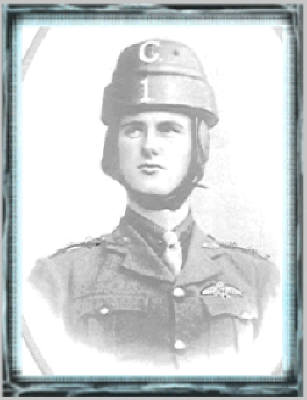
There is even a touch of arrogance about the face. The arrogance born of the time spent in a British Colony in a family of the ruling sort; and later in a top exclusive and expensive school for young Catholics in the North of England; and later still in a university of the young Commonwealth of Australia. This young man is obviously on the threshold of life where adventure beckons in the name of duty to country, family and God.
The second photograph was taken only some few months later. The face under the forage cap has the same elegant cast of features, but is marred by a medical dressing by the left eye. There is still a smile but one that is less sure, less certain. It is now a younger more vulnerable face reflecting the harsh reality of life experienced recently at first hand. There is something about the expression that indicates anticipation of a sequel as yet unknown, but possibly close at hand, yet still hopeful of a realisation of original ambitions to serve gloriously for the country in the new air service. But the man-boy’s body in the photograph says more. The plaster by his left eye and the left arm in a sling show that Sydney has been badly hurt and, whilst recovering, does not want more injury. But there is resignation in the eyes that duty still calls and must be answered with as much courage as can be mustered from a battered body and wounded mind.
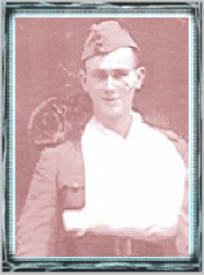
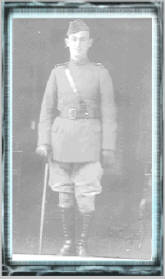
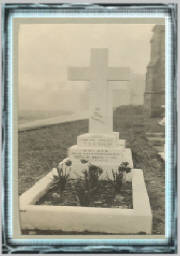
As he made his approach to land he turned downwind. But the aeroplane was nose heavy and it dropped "like a stone" when he turned. "I could not lift the nose…."
The machine hit the ground at 105 miles an hour and lost its undercarriage on the first impact. It then somersaulted three times. By an incredible stroke of good fortune there was no fire. " I was left upside down in what was left of the cockpit amidst twisted wreckage and could not get out because of my safety harness and my injuries." He had broken his left arm/hand in three places and had badly cut his face, again suffering shock. He was admitted to Oak Park Carlow Hospital in Ireland for subsequent convalescent leave where the second photo must have been taken. It shows him still with his arm in a sling and hobbling around with the aid of a walking stick. He left the convalescent home early in December when he wrote home to Australia to say that he was now "OK again and flying as well as ever".
Why the difference? Well it is ashort story quickly told.Sydney was accepted for training as a pilot in June 1917 with the Australian Flying Corps. He transferred from the 48 th Battalion of the Australian Imperial Forces in July to become a cadet at the Royal Flying Corps Training Squadron near Oxford. Two months later he was commissioned into the AFC after completing his basic training as a pilot at the end of September 1917 at the Central Flying School in Up Avon Wiltshire. He was then posted to an RFC unit in Lincolnshire for advanced training.
On October 10 th he suffered his first accident crashing an old De Havilland 4 Biplane. Details of the crash are sparse, but the machine was a write off and he suffered shock and a leg injury.
